| Soft Centre 3 |

MOST PEOPLE will probably have played a version of Mission Omega under some other name, such as City Bomber or Blitz. From an aircraft which flies a little lower each time it crosses the screen, you must flatten the buildings below to avoid crashing into them as you lose altitude gradually. In this version, you must shoot horizontally at the meteors; enemy aircraft also complicate a pilot's task. Points are scored for each building, meteor or aircraft destroyed.
Some effort has been made to enliven and improve this now rather tired scenario. You can determine the level of play by changing the speed of your aircraft, the height of the buildings, and the number of meteors and enemy aircraft. When you crash, a damage report is issued and a dirge is played. Even at the fastest speed, the action is slow and flickery and the graphics are scarcely impressive, with the buildings looking more like pencils than elegant skyscrapers.
Mission Omega is distributed by Warwick Distribution, London.
| MISSION OMEGA | Memory: 48K | Price: £2.95 | Gilbert Factor: 4 |
MOSQUITO-LIKE aliens swirl above your armoured car as you bounce your way across the pitted surface of some distant moon. Armour-piercing missiles home-in from the sides and all you can do is to keep firing and drive with the utmost care in Moon Buggy for any Spectrum. The game will be familiar to high-scoring arcade aces as a tough variant of the shoot-'em-up space games.
The buggy is meant to be a slow tracked vehicle fitted with gizmos which will hurl the machine into the air, enabling it to avoid the craters and cracks. If the tank falls into a hole the wheels will fall off and you have lost one of your five lives. For protection the buggy fires shots up and sideways. The aliens become progressively smarter and there are 16 types to contend with on eight screens.
The sprite graphics are smooth, well-designed, with brilliant colours. Action is fast and edgy, timing being very important once the player attempts to drive away.
It makes sense to find a wide, flat place to stop and fight it out, risking driving only when there are few aliens remaining.
A good score can be run up in that way, whereas travelling is extremely difficult and hazardous. The cassette instructions are clear but the trouble is they are incorrect. To load you must LOAD""CODE and that all-important instruction has been bungled on the insert. That is a pity, as Moon Buggy is an exciting game, though the format remains fundamentally the same throughout. If you are an arcade freak you will enjoy the Visions program even if you curse because of falling into too many craters.
| MOON BUGGY | Memory: Any Spectrum | Price: £6.95 | Joystick: Kempston | Gilbert Factor: 6 |
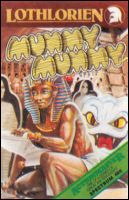
THE OBJECT of Mummy Mummy is to bury yourself. You are an Egyptian mummy rudely awakened from the slumber of centuries by archaeologist Mad Clive. Now you must wander through your pyramid seeking the mystic cartouches which hold the key to your burial rites.
The screen shows a cross-section of the pyramid, which consists of a series of tunnels connected by ladders. The tunnels are inhabited by monsters and ghosts which you must trap by digging holes for them to fall through. They in their turn will try to block your progress by cornering you.
Although the game is challenging, you need a large number of cartouches to win and the mechanics of running up and down ladders and digging holes become tedious after a time. It is a pity Lothlorien could not have introduced more variety into the game, as the initial idea was inventive.
| MUMMY MUMMY | Memory: 48K | Price: £5.95 | Gilbert Factor: 6 |
YOUR FIRST encounter with Orion, from Software Projects for the 48K Spectrum, will be crucial in deciding whether you want to continue with the game. The laser rifle sound which presumably is meant to encourage you to enter play is excruciating, as is much of the noise during the action. Warning - switch out any amplifier you may be using.
The setting, at least as described on the insert, is vaguely galactic, your mission being to rescue 100 of your Beta androids from the clutches of Nedab, a space fiend, and his green Zygon guards who are also aided and abetted by purple power guzzlers. There are 25 grid-shaped caverns through which you must drive your Orion buggy, collecting four frog-like androids from each. You will be destroyed if you come into contact with the Zygons, though the buggy has force shields for protection. Movement is by the keyboard or Kempston or Soundstik joysticks.
The program is, in fact, a Pac-man variant, not offering much of any real originality, though the game is well-made and colourful. The graphics can be confusing at times, especially if you have to use the family's back-up monochrome set, and it is all too easy to mix up who you are, who they are and where you are. Despite the professional production, the concept is well-worn and will appeal mainly to inveterate maze-runners hopelessly addicted to guzzling ghosts.
| ORION | Memory: 48K | Price: £6 | Joystick: Kempston or Soundstik | Gilbert Factor: 5 |
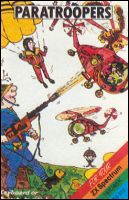
A NUMBER of computer games are firmly grounded on the pleasures of zapping anything which moves and as long as the enemy is represented as Martians or monsters, nobody minds too much. Paratroopers, however, makes no attempt to disguise its warlike theme.
The object is to prevent a swarm of paratroopers landing by firing your anti-aircraft gun at the helicopters from which they jump or at the paratroopers.
If you allow three paratroopers to land either side of you, a tank will appear and blow you to smithereens.
The graphics and explosive effects of Paratroopers are extremely effective but so much realism can be regarded as a disadvantage. The storyline also lacks variety, so that however much you like lining up things in your sights and firing - shooting at paratroopers becomes monotonous in the long run. Produced by Rabbit Software, Middlesex.
| PARATROOPERS | Memory: 48K | Price: £5.99 | Joystick: Protek | Gilbert Factor: 4 |
THE 3D perspective style of graphics so cleverly demonstrated in Ant Attack is bound to breed offshoots. Pedro from Imagine for the 48K Spectrum is in a similar mould, though the graphics are not so complex and the theme not so absorbing or original. The scene is a carefully-tended garden in Old Mexico where Pedro the gardener has created a fine flower garden. The quality of the blooms is such that all the animals in the area sneak in to browse on them and Pedro stands guard to protect his work from their ravages.
He can choose either to jump on them with his boots or try to block their way with bricks and compost, convenient stacks of which are placed around the walled precinct. A shady tramp will appear now and then in an attempt to steal seeds from Pedro's store. He, too, has to be driven off if the garden is to be preserved intact, for Pedro can re-seed the flower beds with his stock if he can find the time.
Rats, ants, cats and stags assail poor Pedro and he must move very fast to keep his score mounting, since a clock is also ticking away the seconds. The dogs even lift their legs to the plants.
Pedro is moved by the keyboard or by a range of joystick options, though the keyboard was difficult to co-ordinate given the speed of action. The graphics are attractive but flickery at times and it will take the player a time to get used to the system of movement. The theme may not have as broad an appeal as more aggressive games but the program is of excellent quality, requiring practice and skilful handling to attain high scores.
| PEDRO | Memory: 48K | Price: £5.50 | Joystick: Fuller, Sinclair, Kempston, AGF, Protek, Arrow keys | Gilbert Factor: 7 |
ARCADE ACTION is combined with a scenario reminiscent of many adventure games in Sorcery from Virgin Games. Assuming the role of the last great sorcerer still at liberty, you are travelling to Stonehenge in an attempt to rescue three captive fellow sorcerers before the evil Necromancer turns them all to stone. Flying is among the sorcerer's magical skills and mastering his movement is one of the challenges.
Each screen represents a different section of the journey - woods, wastelands, castle, river and so on - and as the sorcerer exits from one scene it scrolls to the next. Various hazards pursue him; an encounter with any of those reduces the sorcerer's strength.
What with the time factor, encounters with demons, and the possibility of falling into the river and drowning, it is difficult to get anywhere near Stonehenge, a full 15 screens away, let alone arrive with the correct equipment to foil the wicked Necromancer. The attempt is addictive and lively graphics provide an appropriate atmosphere.
Sorcery is from Virgin Games, London.
| SORCERY | Memory: 48K | Price: £5.95 | Gilbert Factor: 7 |
THERE is a game called Squad Leader, a board wargame where players fight out small platoon-level World War Two operations with cardboard counters and a set of very complex rules.
While Special Operations is obviously not based on Squad Leader, the Lothlorien game has a similar setting and clearly belongs to the tradition of board games requiring strategic thought.
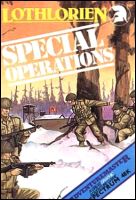
In Special Operations you must choose a small team of commandos to complete one of seven missions centred on a top secret enemy compound.
You may be required to photograph the compound from a distance or to mount a full-scale operation to sabotage whatever evil weapon is being produced there.
The members of your team will have two special skills - one you know immediately and the other you can find by interviewing likely candidates before the mission begins, although there is not sufficient time to interview everybody.
Which characters you choose is a vital part of the game, as you will need to select those skills which best suit the mission you have chosen.
Because of the variety of personnel from which to choose, Special Operations has a role-playing flavour about it. The test of a good role-playing game is how far it enables you to succeed by entering into character rather than thinking all the time about the rules. Special Operations seems to achieve that within the confines of a computer-moderated game.
The scenarios begin by having you parachuted into a heavily-wooded area near the enemy compound. You will move round the grid-like map avoiding or fighting the German patrols until you reach your objective. The maps may be inaccurate. All you can be sure of is what you can see immediately you.
The program has a separate combat routine. A map is drawn on the screen showing your position and you choose targets for your men and manoeuvre them about the terrain using the available cover to protect them.
All kinds of tactics are possible at that stage. You can try outflanking the enemy or pinning them down with covering fire while sending your men into the open to attack.
Special Operations is not a fast-moving, all-action game. It requires imagination and careful planning to play well but for those who enjoy a more thoughtful game the experience is rewarding.
The seven scenarios are slightly different each time you play, as is the range of characters available. Alternatively, you can use the Save Game option to keep the same team and set-up for a sustained campaign working through all seven scenarios in order.
Lothlorien has produced a welcome addition to the range of strategy war-games available and deserves praise for its success in creating the proper atmosphere of stealth and desperation.
| SPECIAL OPERATIONS | Memory: 48K | Price: £5.95 | Gilbert Factor: 8 |
SPECTASORT for the 16K/48K Spectrum is a companion program to Spectadraw. It can either be used on its own to generate permutations or MERGEd on a 48K machine with Spectadraw to use its predictions.
Using a statistical method it generates 10 eight-from-10 permutations from the 14 matches considered to be the most likely draws and the 10 matches considered to be the least likely.
With any program of this kind it is anyone's guess whether the method will win more money than a pin and a blindfold. If it were so good the author would make so much money from the pools that he would not need to sell cassettes.
| SPECTASORT | Memory: 16K | Price: £9.95 | Gilbert Factor: 4 |
SUPERCODE for the 16K/ 48K Spectrum by CP Software is aptly named. What else could you call a collection of 102 machine code programming aids? Details of each routine are given in the instructions, including the start addresses, so that you can use them in your programs. Eighty-eight of the routines are re-locatable.
Many of the routines are useful in games writing, letting you scroll in eight directions in high- or low-resolution or the attributes. Other routines produce a number of sounds and there are also six ways of protecting a program, including ON ERROR, GO TO and ON BREAK GO TO.
All the usual toolkit type of routines are available, block delete, remkill, compress and two kinds of re-number, plus other useful utilities such as hex-dec converters, hex loader, tape head reader and many more. There is even one which accents letters.
There are one or two omissions, such as trace, but it must be the most comprehensive collection available. Even Microdrive users are not forgotten, as there is a routine included to save the whole thing to cartridge.
| SUPERCODE | Memory: 16K | Price: £9.95 | Gilbert Factor: 8 |
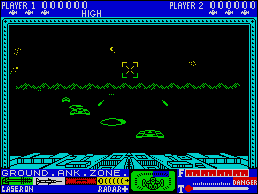
YOU KNOW the story. They need some poor sap to pilot the latest Z5 Luna Hover Fighter through hordes of enemy tanks and aircraft and missiles on a suicide mission to destroy the aliens' base.
The screen shows the view from your cockpit - a bleak, dark landscape teeming with hostile craft. At the bottom of the screen there is an array of instruments - radar, laser beams, missiles, shields, temperature gauge and the like. The controls are difficult to handle and of the type where you lose position rapidly through having to over-correct continually. A joystick is probably vital but it is difficult to survive long enough to find how to use even that with any skill.
That is clearly one for the cognoscenti, the experienced veterans of shoot-'em-up programs, and Hewson Consultants proudly calls it the latest and most difficult in its Seiddab saga. To go with the game there is a taped pep-talk and briefing from your laconic commanding officer.
If your fingers are used to coping with the alien hordes you might get something from this. Newcomers and klutzes had better go elsewhere for death or glory.
| 3D LUNATTACK | Memory: 48K | Price: £7.95 | Gilbert Factor: 6 |
IN SPITE of simple graphics and the unforgivable way in which it massacres the well-loved Für Elise by Beethoven, Timebomb is likely to win an enthusiastic following among those who enjoy an entertaining and novel game.
On a screen representing a grid of blue squares you must guide the hero Cedric towards a series of six bombs in time to prevent them exploding. Each bomb is set to explode after 30 seconds and as soon as one is defused another appears at a random place on the screen. You score points as you pass over the squares and lose one of your three lives whenever a bomb explodes.
Adding to the complexity of the plot are bonus points to be gained from picking up flags or reaching a bomb quickly, and hazards to be avoided such as skulls and boots. What really makes the game interesting is the way in which the blue squares disappear once Cedric has stepped on them, making it impossible to go back over the same route. There is also a scrolling facility enabling you to line up Cedric with a bomb without losing any of his squares, as well as a wrap-round facility which allows you to go off the edge of the screen and re-appear at the opposite end rather than go to the trouble of crossing it.
As the bombs tick away, snap decisions must be taken as to which route is the quickest, safest and most productive of points, while nimble fingers are needed to guide Cedric safely and smoothly to his target.
Timebomb appears to have found the proper balance for an amusing and addictive game. It is produced by CDS Micro Systems.
| TIMEBOMB | Memory: 48K | Price: £7.95 | Gilbert Factor: 7 |
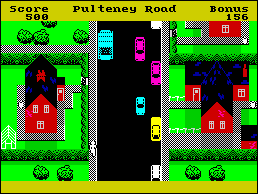
IT IS a tough life working on the bins in the excellent Trashman from New Generation. The arcade game simulates a day in the life of a dustman as he collects the rubbish bins of suburbia and empties them into the dustcart. Unfortunately there is a time limit on each series of jobs, indicated by a decreasing bonus score. When it reaches zero, the residents complain about you and you get the sack.
The screen displays a realistic view of small-town side streets with pretty red-brick houses in 3-D perspective. When you reach the top of the screen the display moves to the next section of road.
The race against time would be difficult enough without all the extra hazards. If you walk on the grass you lose bonus points fast and there is traffic to avoid when you cross the road. The driver has a mind of his own and will not wait if you are slow, but drives on, forcing you to run after him. There are also vicious dogs which leap out to bite your ankles and slow you.
You can increase your bonus by chatting to friendly residents who may give you tips.
| TRASHMAN | Memory: 48K | Price: £5.95 | Joystick: Kempston, Cursor, ZX Interface | Gilbert Factor: 8 |
SOMEWHERE in the remoter reaches of the galaxy, on the backward and barren planet Noom, Brian Skywalker, space shepherd extraordinaire, is having a spot of trouble with his tribbles. Tribbles are engaging but maddening items of alien livestock which will not stay where you put them and have no concept of personal safety.
That is a pity, as almost every other lifeform on Noom thinks that tribbles make a very tasty snack. In Tribble Trubble from Software Projects, Brian's Noomrover, full of captured tribbles, has broken down at the foot of Firebug mountain and, somehow or other, you must help him herd his flock to safety through five screens of hazards. That is no mean task, as while you are digging for gems and bridging the waterfall with rocks to provide your means of escape, those tribbles are wriggling out of your ship and have to be rounded-up and stowed back in the hold. Otherwise, the firebugs will nip down for some fast food and you will be out of business.
The program features attractive, fast graphics and a series of complex and taxing problems which encourage you to return again and again to the game. You can use either the keyboard or a Kempston joystick for movement and there is a full demonstration mode at the beginning of the game, coupled with entertaining music. Tribble Trubble is a highly amusing and original arcade-style game. It demands a great deal from the player but gives good value and is a refreshing change from zapping aliens.
| TRIBBLE TRUBBLE | Memory: 48K | Price: £5.95 | Joystick: Kempston | Gilbert Factor: 8 |
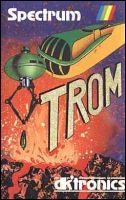
IF YOU thought Trom might bear some resemblance to the film of almost the same name, forget it.
The cassette insert has a confusing tale of collecting bits while avoiding pixels and nibbles. There are some bouncing bytes knocking around as well.
It seems dK'Tronics could not think of any remotely credible background for what proves to be a thoroughly uninspiring game.
Briefly, you have to run round the screen picking up red blobs - 'bits' - and carry them to a fiery furnace. The 'bytes' look like purple bars and rebound from the walls. Other features try to track you down and shoot you.
The game is easy to play and there are three levels of difficulty. Successive screens appear to produce only more of the same and the only positive feature is a facility for choosing which keys you use for the controls.
Unbelievably, there appears to be no provision for the use of a joystick.
dK'Tronics has produced many good games in the past. Trom is certainly not one of them.
| TROM | Memory: 48K | Price: £5.95 | Gilbert Factor: 4 |
TT-S from Timedata is a collection of five programs for the 16K/48K Spectrum, designed to make life easier for programmers. It was written originally by Timedata programmers for their use.
GAMMA is 4,410 bytes of re-locatable code which give you an extra 10 keywords and also prevent you entering NEW or deleting a line accidentally. The extra keywords are AUTO, which generates line numbers automatically; RENUMBER; block DELETE; MOVE, FIND a string; TRACE on and off; FREE, the number of free bytes; VARIABLE dump; and HELP, which lists the new keywords.
To enter one of the new commands Symbol Shift and 0 are pressed to change to a T cursor, followed by the relevant key. The program can be used with a Microdrive.
SCREEN is a useful highres drawing program with all the usual commands, such as fill and text insertion, but excludes circle. UDG displays six UDGs in an enlarged 3 x 2 block. As you change them you can also see the real size display change.
TAPE is a standard tape head reader which gives details of the type of program, name, length and auto-run line number. RAM is a memory test program which tests each bit in each byte of user RAM, including the screen. The collection has something for everyone and is well worth buying.
| TT-S | Memory: 16K | Price: £7.95 | Gilbert Factor: 8 |
MILITARY strategy games should be complex and well-devised if they are to satisfy war-gamers and should enable the player to develop tactical skills. Programs like Johnny Reb and Apocalypse are examples which demonstrate those qualities. Regrettably, Wilfred the Hairy, Olaf the Hungry from Microbyte does not fulfil those requirements and left the reviewer wondering why the game has been produced in such an apparently unfinished state.
The intention of the programmer seems to have been to create a world-wide, map-based conflict between two armies captained by the aforementioned heroes. The computer acts as one and the player takes on the role of the other.
You may move your "piece", drawn as a rather sketchy warrior, across the continents, returning when your ammunition is exhausted to your equally sketchy base. There are no easily-distinguishable screen prompts to show when it is your turn and instructions are very limited.
It really seems as if the computer is hogging all the play, leaving you a few brief moments in which to move round the board and deposit flag markers to show your territory. There is no effective combat sequence, except a small graphics window which displays sea fights using a movable cannon and enemy warships.
After a time it seemed easier to let the computer carry on alone as there was no stimulus to play and no excitement or skill if you did. It is an undistinguished and tedious game offering little originality or playability.
| WILFRED | Memory: 48K | Price: £5.50 | Gilbert Factor: 2 |
AS Pamela Stephenson once warbled on Not the Nine O'Clock News: "Nice video, shame about the song". Zig-Zag from dk'Tronics is a beautifully-presented game with excellent graphics and smooth, fast action, but it suffers from a repetitive and not specially original concept.
You have to patrol your sector seeking the Scarabaqs, beetle-like nasties with pointed teeth. Each sector is a network of corridors portrayed on the screen in 3D-style graphics. The Scarabaqs supposedly hold the data necessary to enter the next sector and as you progress through the game you have to capture more Scarabaqs at each level.
The screen display is cockpit-style and apart from the view of the corridors you have status indicators and a direction indicator.
The graphics are very fine. The cockpit view changes swiftly and smoothly and the Scarabaqs look suitably bug-eyed and vicious when cornered. It would have been pleasant to see more variety in the game rather than a mere increase in difficulty with each new level.
| ZIG-ZAG | Memory: 48K | Price: £5.95 | Gilbert Factor: 7 |